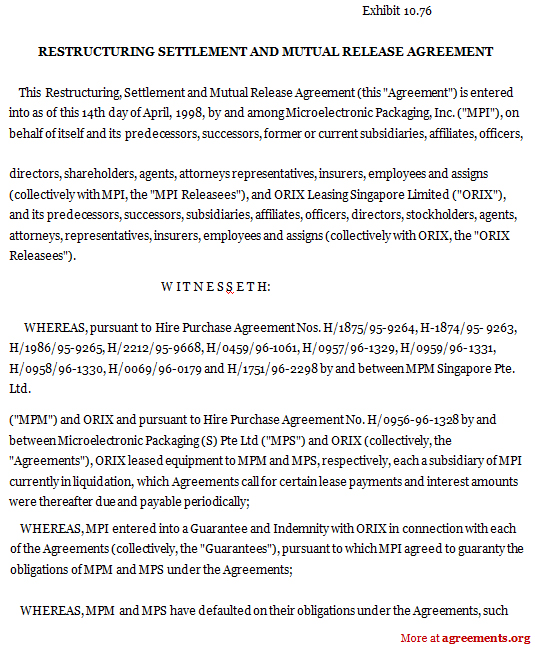Also known as a settlement and release agreement, restructuring settlement and mutual release agreement are signed between two parties, where they agree to settle all obligations in full and ensure there are no pending liabilities and obligations between the two signing parties.
The agreement serves to protect the interests of the parties, allowing them to settle the dispute outside the court. This agreement is usually used in a business setting, where the directors and shareholders are the two signatories. However, it can also be used by employers, creditors, and in real estate.
When Do You Need Restructuring Settlement and Mutual Release Agreement?
Usually, you need a restructuring settlement and mutual release agreement when one party has to pay for another party, but there are some obstacles in clearing the dues. Instead of seeking legal recourse, the two parties sign the agreement where one party pays the dues in entirety while the other party agrees not to go to court.
The agreement ensures that both parties do not have to resort to a legal battle to settle their differences. Instead, the agreement works to resolve any issues they may have outside the court.
Purpose of Restructuring Settlement and Mutual Release Agreement
Civil lawsuits are expensive and can take years to resolve. Under such circumstances, settling issues outside the court is a quicker and faster option. The primary purpose of the agreement is to serve as evidence that the two parties have agreed to the settlement and release terms and that neither party will approach the court.
Inclusions in Restructuring Settlement and Mutual Release Agreement
The agreement will have standard boilerplate clauses. In addition, the restructuring settlement and mutual release agreement will have terms and conditions and certain other details that are specific to the agreement. Basically, here it contains the terms and conditions that the two signing parties have agreed to. Some of the inclusions in the agreement include the following:
- Names of the two parties
- Address of the parties signing the agreement
- The date when the agreement will be executed
- The legal section under which the restructuring is taking place
- The authorized body that has acquiesced the agreement
How to Draft the Restructuring Settlement and Mutual Release Agreement?
When drafting restructuring settlement and mutual release agreement, the following should be included in the agreement:
- Both the parties should come to an understanding of the settlement and release
- Thereafter, the attorneys of the two parties create the agreement
- Identities of the parties and their lawyers are stated in the agreement
- Mention the amount and date by which the releasee should pay the entire amount
- Purpose of the payment
- Dismal of the lawsuit, if any, and by when
- Any other obligation or liability that the releasee has towards the releaser should also be stated and the date by when the releasee will fulfill the obligations and liabilities
Pros and Cons of Restructuring Settlement and Mutual Release Agreement
Some of the advantages of restructuring settlement and mutual release agreement are as follows:
- Ensures a clear settlement between the two parties
- Does away with the need to seek legal intervention as civil cases are expensive and can take time to come to a conclusion
- Safeguards the releaser against future legal claims
- The releasee gets a clean break
Some of the disadvantages of the agreement are as follows:
- The cost of getting attorneys to draw up the agreement can be expensive
- Can adversely affect the relationship between the two parties
- Can cause damage to the reputation of the organisation in the industry
Types of Restructuring Settlement and Mutual Release Agreement
Restructuring settlement and mutual release agreement can be used in different situations and scenarios:
- Between shareholders and company
- Between buyer and seller of the property
- Between landlord and tenant
- Between creditor and borrower
- Between two entities
In each type, the standard clauses will be the same, but the specific terms and conditions will be unique. In addition, the signatories and their attorneys can add other key details that are specific to the verbal understanding and negotiation that the two parties have had.
[Also Read: Restructuring Agreement]
Key Terms / Clauses in Restructuring Settlement and Mutual Release Agreement
Some of the key terms of restructuring settlement and mutual release agreement include the following:
- No Admission of Liability: It means that both the parties are not admitting to any wrongdoing, but are entering into the agreement to avoid further litigation
- Terms of Settlement: The total amount that is paid as compensation by one party to the other and the date of execution of the settlement
- Tax Consideration: The signing parties will not claim reimbursement from one another if there are tax consequences
- Dismal of Litigation: The party that has filed a civil suit agrees to get the case dismissed
- No Other Claim: Understanding that there are no outstanding claims now and in the future after completing the settlement
What Happens When You Violation?
If you violate the restructuring and mutual release agreement, the other party can initiate a civil claim against the violation or go back to court where the initial lawsuit was filed.
Sample Restructuring and Mutual Release Agreement
If you are looking for a restructuring and mutual release agreement, you can download an original agreement from here. You can make amendments to the agreement based on your requirements.

Download this attorney made agreement for $9.99 only
By clicking the button below, I agree with the Terms & Conditions.